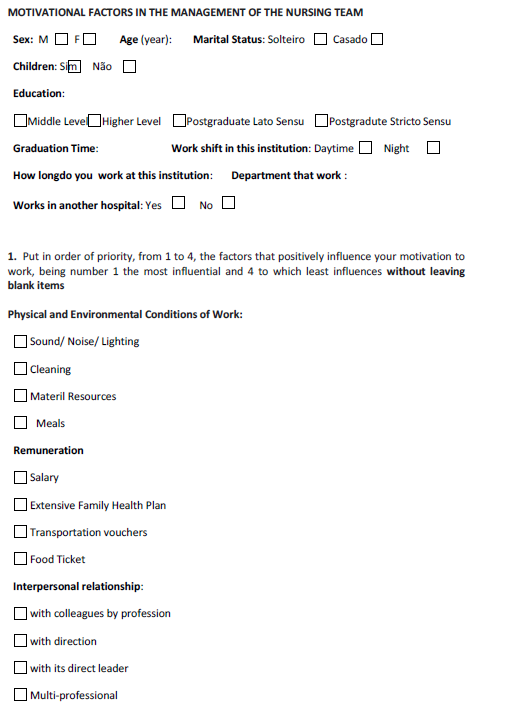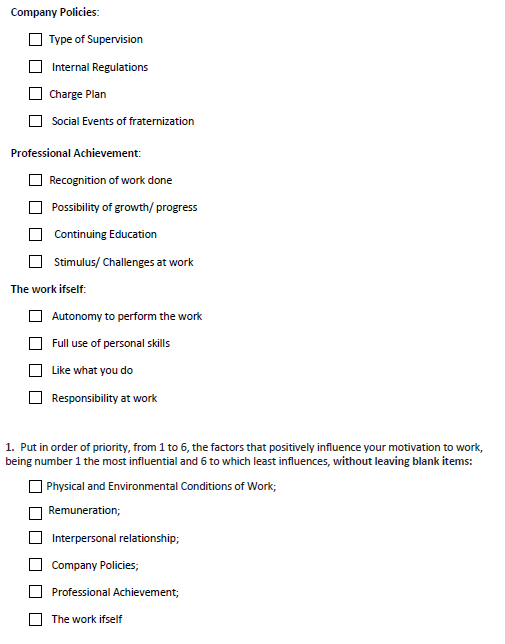Mi SciELO
Servicios Personalizados
Revista
Articulo
Indicadores
-
 Citado por SciELO
Citado por SciELO -
 Accesos
Accesos
Links relacionados
-
 Citado por Google
Citado por Google -
 Similares en
SciELO
Similares en
SciELO -
 Similares en Google
Similares en Google
Compartir
Enfermería Global
versión On-line ISSN 1695-6141
Enferm. glob. vol.16 no.47 Murcia jul. 2017 Epub 01-Jul-2017
https://dx.doi.org/10.6018/eglobal.16.3.249471
Originales
Nursing team management: factors associated with job satisfaction
1Master in Nursing. Nurse of the National Institute of Traumatology and Orthopedics. Rio de Janeiro, Brazil.
2Nurse. Master of the graduate program in the strict sense of the Anna Nery School of Nursing, of the Federal University of Rio de Janeiro. Rio de Janeiro-Brazil.
3PhD in Nursing. Assistant Professor of Nursing Department of Nursing of the Anna Nery School of nursing, of the Federal University of Rio de Janeiro. Rio de Janeiro-Brazil.
4PhD in Nursing. Associate Professor of the Department of Methodology of Nursing of the Anna Nery School of Nursing, of the Federal University of Rio de Janeiro. Rio de Janeiro – Brazil
It is aimed to identify the priorities attributed by the nursing staff, related to the factors associated to satisfaction at work and to analyse the influence of those factors in the nursing assistance in different administrations.
Transversal descriptive study with 239 members of the nursing staff of a private hospital in Rio de Janeiro. A form was applied referring to satisfaction at work. Its data were analysed through the software Statistica and two -tailed test of proportions. Equality was found in the priorities attributed by the staff in the different administrations and similarities for most attributes in the tendency of percentual distribution,such as:material resources, salary relationship with co-workers, /leadership, work recognition and work satisfaction.
It is up to the managers and leaders to find alternatives that favour motivation such as: review of internal policies , institution of career plans /incentives, feedback to staff aiming to meeting their expectations , achieving improvements in interpersonal relations, among others
Keywords: Motivation; Nursing Team; Satisfaction on Job; Human Resources Administration in Hospitals
INTRODUCTION
Currently, the quality is the key word and a debatable subject and worked in the goals and policies of the health organizations. Every institution, whose essential mission is to assist the human being concerned with the constant improvement of the service.
Quality is meeting of competent, effective and secure manner, contributing to the well-being of an individual in all points of contact (medical areas, assistance and support) which may have substantial impact on the rate of mortality, morbidity, disability, and malnutrition (vision clinic); the quality is linked above all to the interactions of health professionals with customers (customer view).1
This matter should receive full attention on the part of managers, therefore, the quality of customer service is directly linked to the satisfaction of the employees to the Organization, especially with regard to nursing staff, to be nonstop in direct contact with the patient in the hospital.
One of the major strategic challenges of organizations currently is the management of people. This model of administration, with emphasis on the flexibility of the system and on intrinsic motivation of employees, believes that the viable organization is one that not only manages to capture and apply properly its human resources, but also keeps them satisfied in the end in your organization. (2
Several factors influence the motivation of the nursing staff, therefore identifies them, represents a trend of behavior that can serve as subsidy for motivational actions, and consequently generate healthcare quality and increased productivity.
This study considers relevant to discussion of this subject in order to corroborate reflexively to the management in contemporary times, in order to contribute to the work of personnel management, in order to reconsider the methods of valuation of employees, aiming to reach of organizational goals.
Front of the exposed, were marked asthis study objectives: identify the priorities assigned by the nursing staff regarding factors related to job satisfaction and analyze the influence of these factors on nursing care, in different managements.
The two-factor theory Herzberg was the first theory proposed to explain the satisfaction with the work. This theory suggested two groups equally important to motivate a team: hygiene factors and motivational factors. The hygienic factors refer to the physical conditions at work, salary, benefits, security, among others, that foster motivation were classified as motivational factors, which are focused on the achievement of the individual self, correspond to the State in which the employee feels with available or willing to work productively. 3
To motivate an employee, it is not enough that the factors of dissatisfaction are absent,on the contrary, the factors of satisfaction (hygienic) must be present, as well as the motivational factorsand (c)conclude that the hygienic factors when they are absent substantial dissatisfaction. 3
The nursing staff suffer your influences working environment that may alter your work performance and such factors may related to individual factors and professional institution. Conditions of patient care may also improve nurse satisfaction at work and possibly contribute to the retention of staff. 4
The job satisfaction is a multidimensional concept, which contains individual skills, attitudes, beliefs and value system. To achieve job satisfaction is important that employees have features of positive feelings, commitment, responsibility as well as critical thinking and planning to achieve special skills. 5
MATERIAL AND METHOD
Transversal descriptive typology study that used the backdrop of a Hospital in the Private Network of the city of Rio de Janeiro, reference the customer service of high complexity. This hospital has undergone a process of administrative and technical management change in the data collection phase, the research was divided into two phases, since the first phase of data collection occurred from February to May 2010, in the old management (1°) and the second phase took place in the period from January to April 2011 in the new management (2°).
Inclusion criteria were nurses and nurse technicians, daytime and nighttime that acted directly on assistance. Exclusion criteria were outsourced professionals and in a period of sick leave at the time of data collection.
The population mapped to 40 nurses and technicians 58 1° nursing management; and 59 and 82 nurses nursing technicians during the 2° management, totaling 239 effective participants in the research. Important to note that the subjects were not repeated in different stages of data collection (1st and 2nd management management).
The collection instrument, supported the theory of Herzberg3, was a structured form with 10 questions covering socio-demographic data and issues 2 scoring the order of priority of the factors that influenced positively on satisfaction to work. In the assessment of the priority scale descending ordinal used where the number 4 corresponded to the smaller influence, while the number 1, the largest. Whereas the satisfaction to work depends on the hygienic and motivational factors3, this evaluation was conducted in relation to the following attributes: Physical and environmental conditions of Work, Remuneration, Interpersonal Relationship, Hospital policy, Professional Achievement, Professional Activity.
In the data analysis, we used the descriptive statistics of the values for each motivational factor, broken down according to their attributes and management, through the Statistica Software.
From the absolute frequency, odds were calculated (value observed in each absolute frequency over the total number of observations), and the results evaluated only by observation, that is, most likely, greater significance. The comparison between the management done by testing two-tailed Proportions.
The ethics and Research Committee of the Hospital research setting under the Protocol n ° 351 approved this study.
RESULTS
Table 1 Relative distribution of respondents according to the physical and environmental conditions of work according to priorities in the two Managements. Rio de Janeiro, RJ, Brazil (2010).
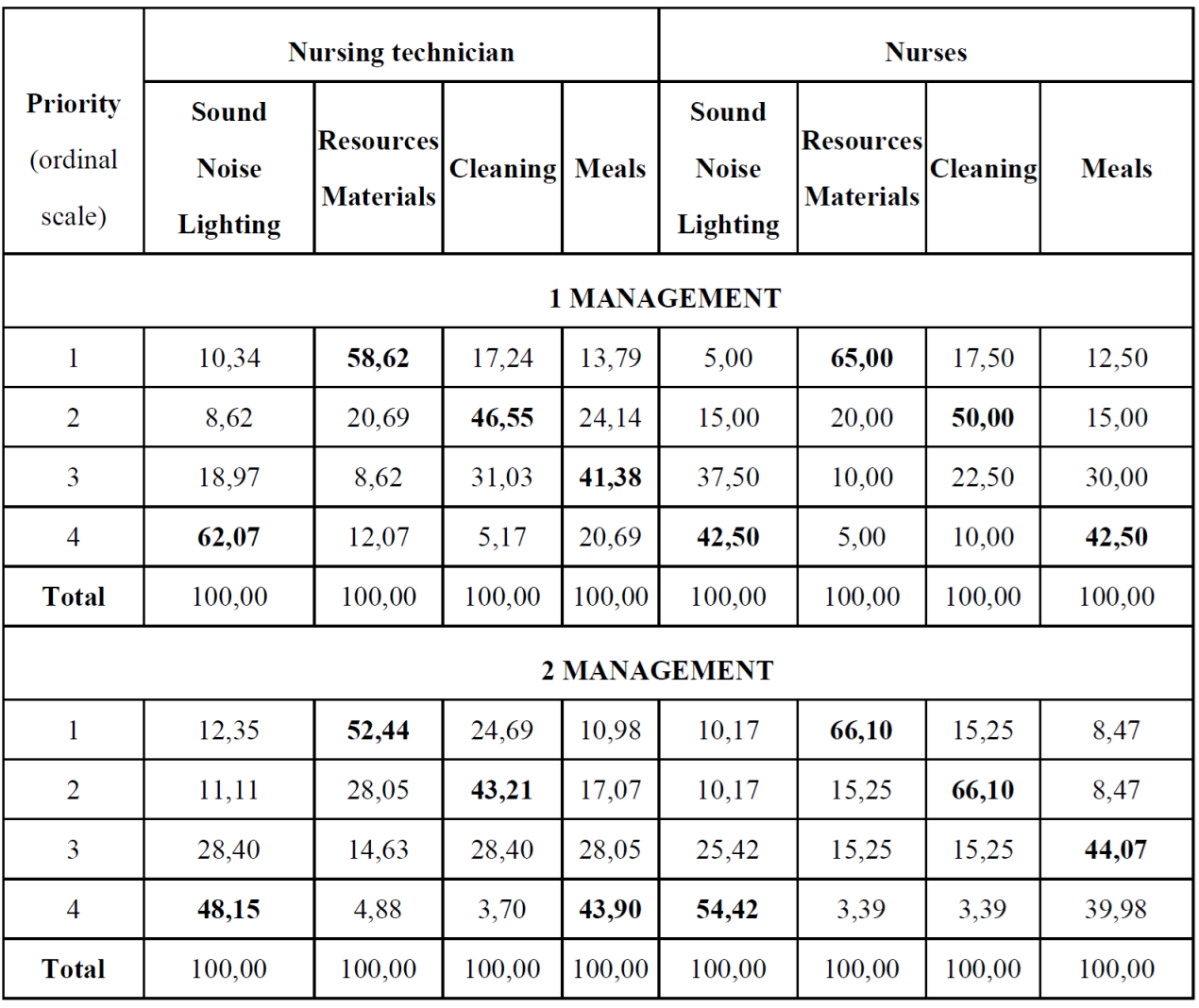
Source: Research data. Elaboration of the authors
Nursing technicians of the two managements and the nurses of the 2nd Management pointed out that the sound/noise/lighting attribute presented the slightest influence on satisfaction to work, while for nurses of the first management, meals served were the most referenced in this Prism in relation to the factor of greatest influence, priority 1, the groups of the different managements, pointed material resources.
In the assessment of priorities in relation to the remuneration shown in Table 2, the nursing technicians and nurses indicated the Salary attribute as the item of greatest expressiveness to your satisfaction at work.
Table 2 Relative distribution of respondents according to the remuneration according to priorities in the two Managements. Rio de Janeiro, RJ, Brazil (2010).
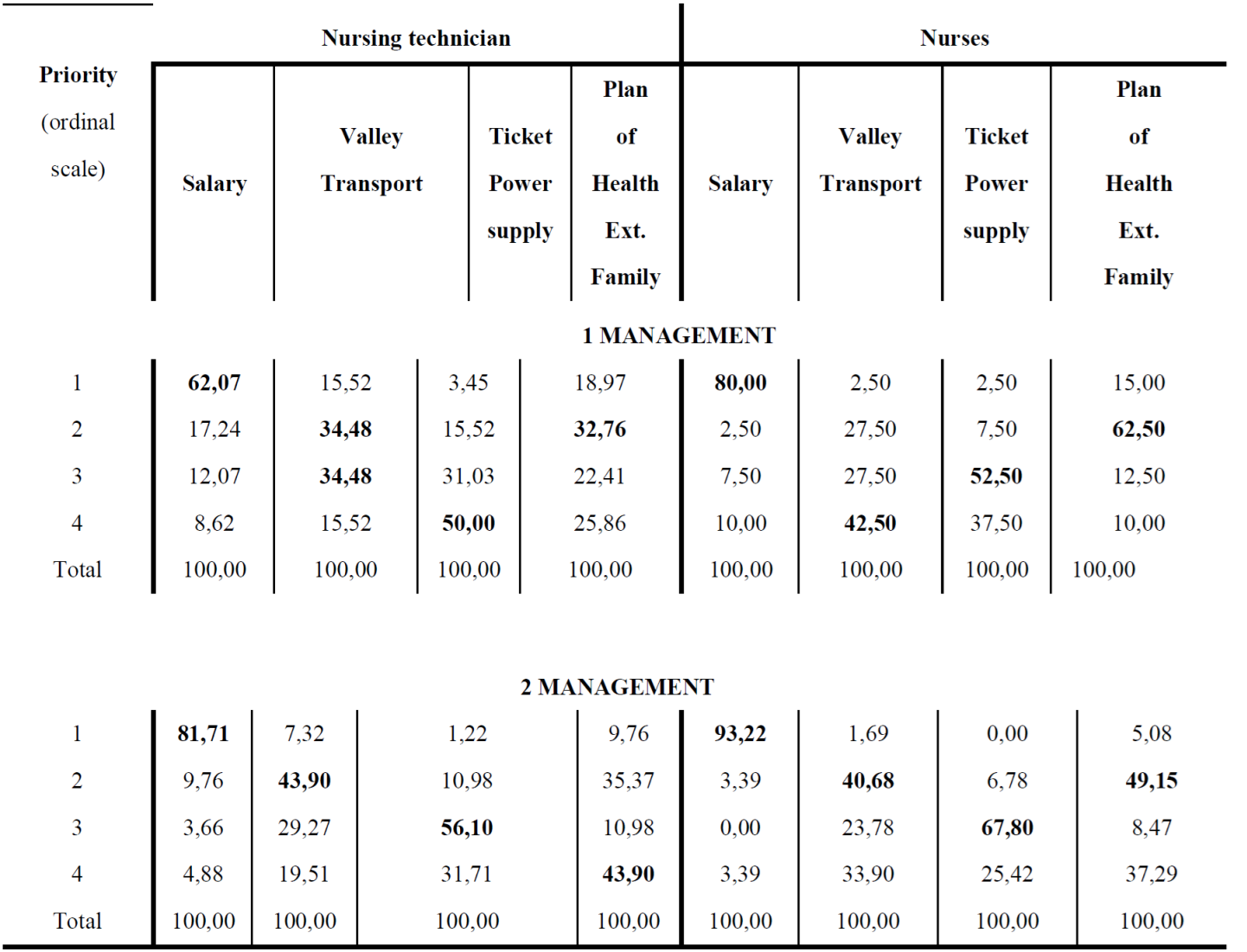
Source: Research data. Elaboration of the authors
Table 3 Relative distribution of respondents according to the interpersonal relationship according to priorities in the two Managements. Rio de Janeiro (2010).
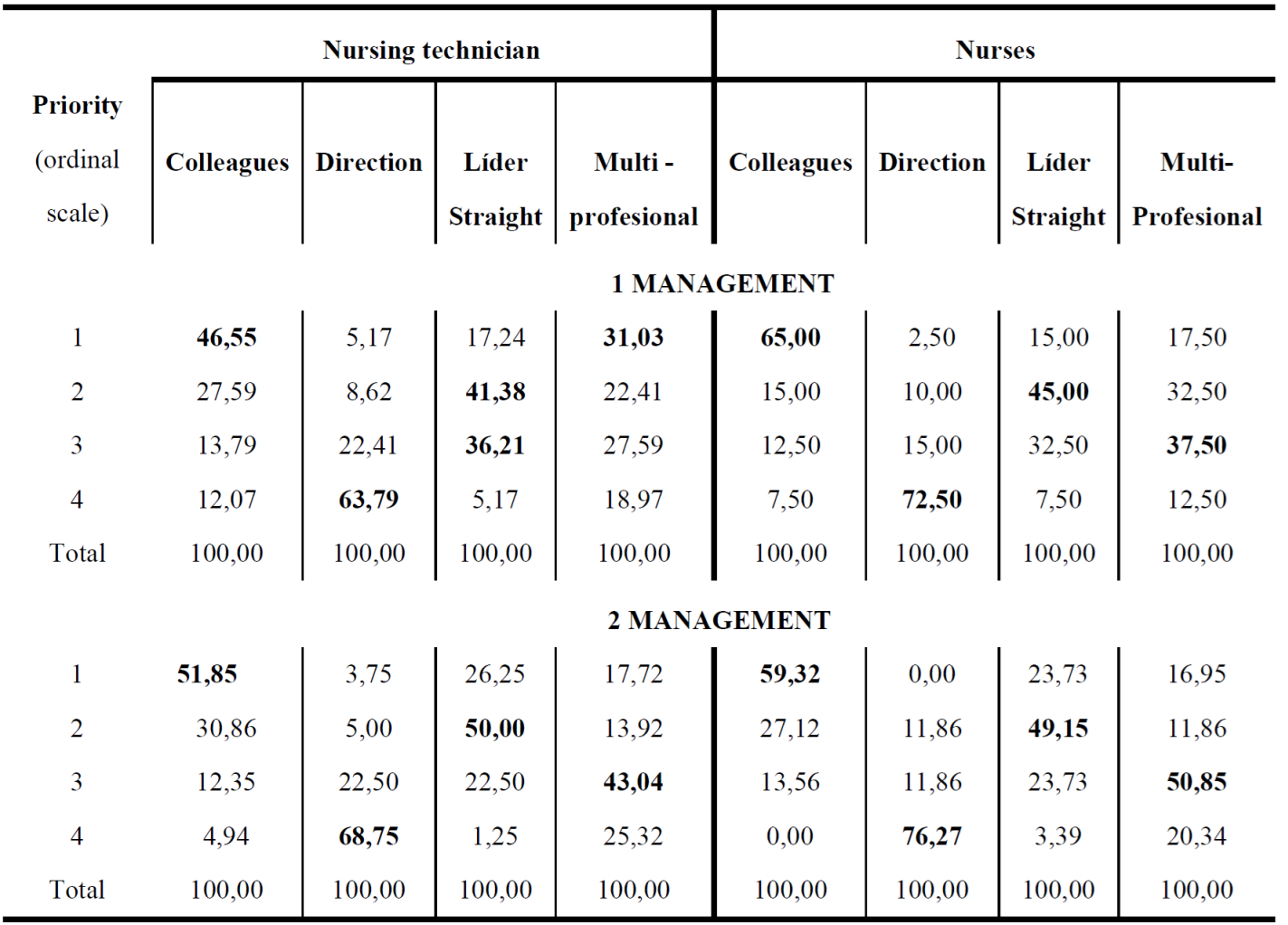
Source: Research data. Elaboration of the authors
The most relevant factor in Interpersonal Relationship of nurses and nursing techniciansbased on the co-workers. Then, the two classes of employees, of the two procedures, valued the Direct Leader. The last priority concerns the Direction, with almost similar proportions for technicians and nurses in the two managements.
Table 4 Relative distribution of respondents according to the policy on the management of the Hospital according to priorities in the two Managements. Rio de Janeiro (2010).
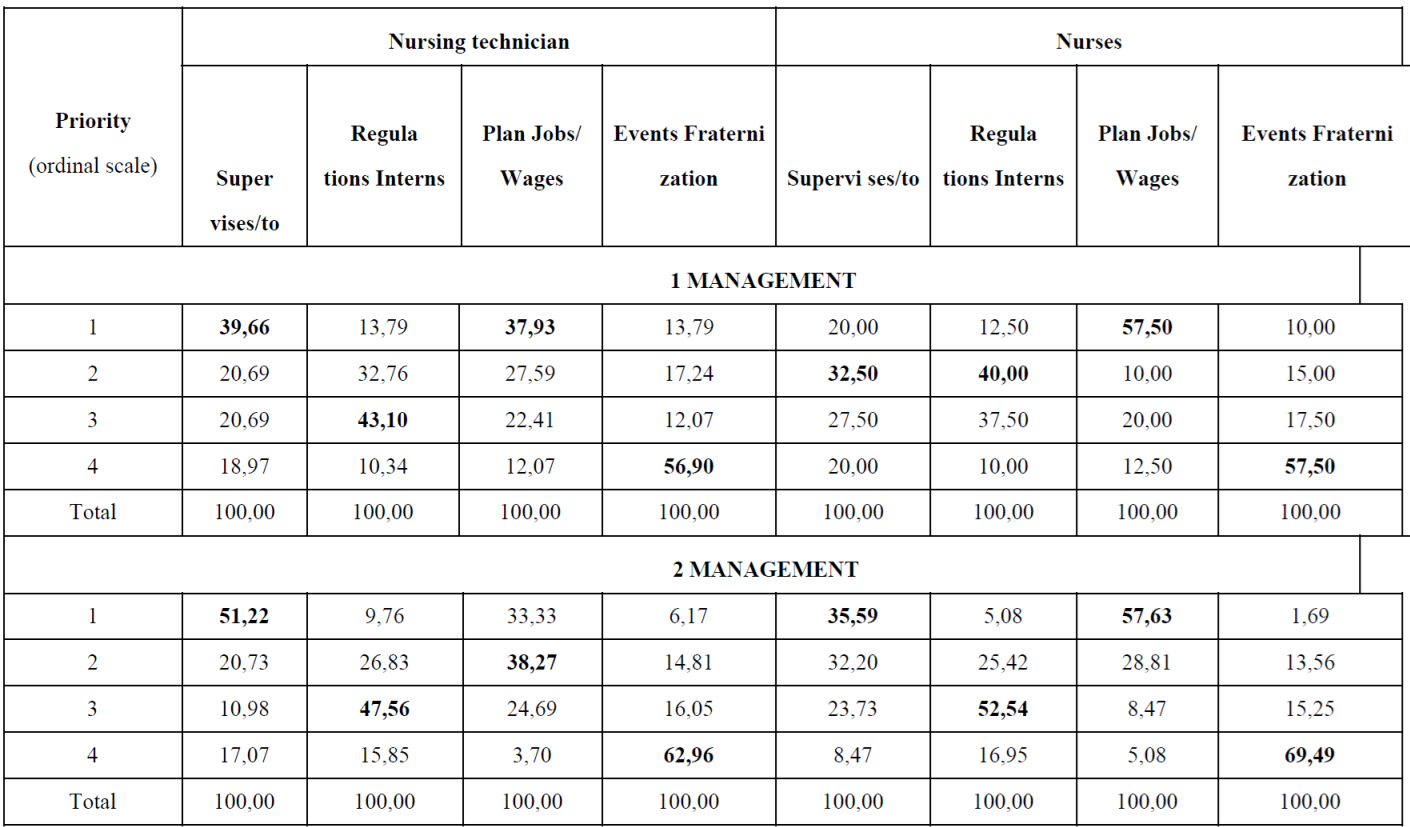
Source: Research data. Elaboration of the authors
The plan of jobs and salaries was the most valued attribute, to the nurses of the two managements. Different nursing technicians of the two managements that have assigned priority 1 how supervised.
The most important factor in motivation to work in front of professional fulfilment, Table 5, was the recognition of the work done, for most attributes similarity occurred in the trend of the percentage distribution in relation to the ordering of the priorities, except for continuing education/training, which was more prized by coaches, which have relevance to priority, opposing the position of nurses, who ordered in third position.
DISCUSSIONS
Material resources are factors of high priority and that influence organizational results. The management of material resources it is important to ensure the quality of carerefers, therefore, to the final product or activity order, through actions that may suffer interruptions, because these often happen by insufficient in quantity, quality and the flawed process of management of material resources. 6
In some institutions, the nurse is responsible for the management of material resources in the inpatient units, noting, however, that there should be a reflective process, because usually the nurse who manages the material resources also works on direct assistance to the patient, which may result in discontinuance of this process, due to work overload. On the other hand, there are institutions in the administration of these resources is performed by an administrative officer, that in your most did not get in your training expertise to plan and assess the need for material resources.
It believed that the nurse is the most appropriate professional to carry out the activities of management of material resources, due to training your administrative activities, coupled with knowledge from social practices. Such connectives provide a distinctive look for the optimization of resources, evaluation and weighting by the choice of materials that meet the needs of patients and professionals, to provide safe care. Nevertheless, it suggested that there are professionals geared exclusively to this activity, where notably nursing ensures your featured by contemplate requirements and skills acquired in the course of the academic and professional training. .7
Front of the exposed, showing the importance of the nurse know about control of the use of materials, to supervise properly the work of your team and still provide education and constant updating of knowledge in order to ensure best quality and financial income in the use of material resources necessary for patient care. 8
In relation to the salary attribute, this greater expressivity, perhaps obtained because this allows not only the satisfaction of physiological and security needs, but also gives full conditions for the satisfaction of social needs, of esteem and self-realization.
Large number of people believe that financial reward is exclusive to more effective to stimulate the motivation at work. However, recent research in the area of Psychology demystify this belief, suggesting adoption of extrinsic rewards - as financial compensation-additions and also - as the stimuli intrinsic feelings of self-esteem, achievement and competence - affect positively the satisfaction, motivation and performance. 9
The company should see the wages as aggregate function of motivation and seek to use it as a tool in making organizational and personal goals. To have integrated, productive people and a motivating environment in the Organization, they believe there is link between remuneration and performance differences, so wages could be an excellent motivator. Needed, therefore, adequate human resources plans.10
Many aspects are the source of dissatisfaction in nursing, in addition to low wages, there is still an insufficient number of nurses on duty generating a great physical and mental workload, a high responsibility and limited autonomy in decision-making.
Another aspect analyzed was referring to interpersonal relationship of nurses and nurse technicians, which showed how more relevant factor for motivation the relationship with your co-workers.
Good interpersonal relationship is a desired tool in the workplace, since the hospital is a place where people spend most of their time. In the context of the study, the hospital environment characterized by being highly stressful and very intense activity, since it deals with situations of morbidity and death.
In this sense, it is extremely important to good communication, cooperation and respect not only among the members of the nursing staff as well as between the health team in General. This facilitates success in activities, as well as provide increased interaction and cooperation, reflecting favorably on the activities and, consequently, the motivation and productivity of the group. 11
On the other hand, when, in the group, there is no interaction, generating negative feelings of animosity and rejection, there is a clearance between these members reflecting negatively on productivity. 11
Yet in terms of interpersonal relationships, we realize, too, that the two classes of employees, of the two procedures, valued the Direct Leader as the second most influential factor in motivation to work. In the world of work, the superior officer is an important reference point for most people.
The motivation in organizations closely linked to interaction leader/follower. The leader's effectiveness related to the positive way in which the follower sees you. The effective leader can facilitate the self-esteem and self-awareness, so the level of motivation and is linked to the individual and your work has strict relationship with competence and sensitivity of the leader. 12
The role of the leader in the formation of a cohesive group is essential, every team is a reflection of your leadership, without a solid reference, the team loses your focus, generating conflicts between its members. The leader must observe often personal and professional behavior of their employees, seeking to identify the strengths and weaknesses of each individual, directing to the pursuit of continuous improvement in both the technical and behavioral aspect. 13 it is important that the leadership understand that lead is not only send his subordinates perform certain tasks, but out front serving as example and North to your team, have a compromised vision and systemic context.
Other studies report that the greatest job satisfaction of nurses is associated with the style of leadership focuses on people and relationships, autonomy to work (control over your practice) and emotional intelligence of the leaders. 14
Relations with co-workers and managers can also strongly influence the decision to stay or not in employment. Ignoring the importance of human relationships can put other professional retention strategies in risk. Strategies that focus on building respectful relationships at work can have a high ability to encourage nurses to remain in the organization. 15
With regard to management policy, the plan of jobs and salaries was the most valued attribute, for nurses from two different managements of nursing technicians that prioritized the way supervised as the most influential factor in your motivation to work. Perhaps the fact that nursing technicians carry out their activities involving participation in the planning of assistance, guidance and monitoring of nursing work in auxiliary grade, impede glimpse a plan of jobs and salaries, so how are supervised influences directly in the execution of their tasks and consequently on your professional motivation.
Administration jobs and salaries is a relevant factor for the company on the retention and maintenance of their intellectual assets, and operates strategically on compensation policy of his talents. (2
How it should managed, the human capital comes to becoming an indispensable factor for the success of organizations. There is generally a need to structure a plan of jobs and salaries, that promote internal equality, estimated wages appropriate to each position, in accordance with the roles and responsibilities, as well as the development of a fairer wage policy. 2
Though extremely important, the plan of jobs and salaries did not become a practice still in the process of managing people in organizations of health. The process of measuring the performance of healthcare professionals designed as an important management resource for professional and personal growth, which requires highly skilled leaders to perform this activity.
The performance evaluation (AD) is one of the instruments that can used for the development of the plan of jobs and salaries, enabling the reflection of important points such as thinking about the working conditions, detect skills, abilities, disabilities and set expectations and goals. 16
Thinking about the AD as a useful tool in managing people, and raising their points of vulnerability, which render it also quite controversial, your deployment requires technical care, demanding, especially a change in attitudes and posture of the people16 This allows reflection of important points such as thinking about the working conditions, detect, abilities and skills deficiencies, set expectations and goals.
It is necessary, therefore the managers reflect and review its methods of managing health care professionals, mainly on account of its specific characteristics, considering the quality of the results of the Organization, as a consequence of human performance.
The use of indicators by the leaders considered one of the essential tools in the management of the nursing staff. The service monitoring of this team through the assistance and administrative indicators, allows recognizing the difficulties of the work, to propose improvement actions and support the decision-making.
The indicators defined as measures used to help describe a situation, assess changes or trends over a period and, in terms of quality and quantity, health actions performed and promote improvements. 17 thus, the use of indicators should become one of the strategies to ensure continuity of work, translating into internal and external customer satisfaction.
Another motivational factor of greater influence at work that deserves highlight is the recognition of the work done. Based on Professional Achievement, this factor was prioritized both nursing technicians and nurses.
The case of motivation to work, is of extreme significance, recognize the efforts of employees. Even though the results are far from achieving the goals, we must not fail to recognize the efforts and encourage improvements. Unmotivated people demonstrate a low level of confidence in themselves, and end up designing about the organization that disbelief, this explains the fact of individuals newly admitted being fully motivated, therefore, carry the expectation that this company will be able to find additional factors to the satisfaction of these needs.
One of the main challenges for all organizations is to maintain employee satisfaction and increase your motivation. It suggested that should carried out, in all health institutions, periodically a survey on the satisfaction of employees and ways to increase your motivation in order to constantly monitor the job satisfaction of all healthcare professionals. 14), therefore, one of the factors that should be developed in organizations is the ability to obtain and maintain self-esteem and hence increasing productivity.
It is worth noting that the goal of every employee is to find some kind of work corresponding to their skills and interests, as much as possible, allowing them to success and providing them opportunities for promotion.
Satisfied employees tend to be more productive and committed to their employers, and there is a direct correlation between job satisfaction and patient satisfaction with healthcare organizations, so employees satisfied should be the ultimate goal of every leader. 13
When a team member establishes healthy relationships within a welcoming environment meets their needs for self-esteem, which, for your time, encourages him to develop a quality assistance, having your work encouraged, appreciated and recognized. Thus, to identify and satisfy the needs of team members, with a view to the motivation of the group, consists of a principle of leadership in nursing.
Nurse leader should possess, to that end, insight on leadership by the power, authority and leadership, especially the importance of serving to team members to identify needs that are direct or indirectly related to the motivation to work. 18
Becomes relevant institutions to seek alternatives by the healthcare team to minimize the factors that contribute to make it disheartened, because this can negatively influence both the quality of the assistance provided to the client, as in the quality of life of the individual who needs to submit daily to an unhealthy environment and demotivating. 10
CONCLUSIONS
In the analysis of the factors related to job satisfaction similarity occurred in assigned priorities for most factors, both of the nurses as nursing technicians, such as: material resources, salary, and relationship with colleagues from work and leadership, recognition of the work done.
After completing the research, it found that independent of the management change that occurred during the data collection, there were no differences in the priorities assigned by the nursing staff to factors associated with satisfaction in the work, despite believing that the change of culture and organizational climate could influence.
It hoped that this study would contribute not only to the work of personnel management of hospital nursing studied, as well as sensitize all healthcare organizations to perform custom studies. It is up to the managers and leaders find alternatives that encourage motivation, e.g., review of its internal policies, establish plans for offices and incentives, provide feedback to the staff in order to meet your expectations, to obtain improvements in the interpersonal relationship, apply coaching techniques in thedevelopment of leaders, among others.
In addition to these alternatives, it is important to perform periodic searches for listing other aspects that related to motivation, since these factors are highly mutable.
Invest in nursing staff, in order to raise the level of satisfaction at work, it is essential to increase productivity and quality in assistance, because this team seen as one of the leading health institutions considered an important competitive differentiator.
REFERENCES
1 1. Regis FC, Gomes JMR. Rumo à excelência no atendimento ao cliente. Einstein: Educ Contin Saúde. 2010; 8(1 Pt 2): 45-7. Disponível em: http://apps.einstein.br/revista/arquivos/PDF/1619-EC_v8n1p45-7.pdf Acesso em: 10 de novembro de 2015. [ Links ]
2. Chiavenato I. Recursos Humanos: o capital humano das organizações. 9ª ed. São Paulo: Elsevier Campus; 2009. Acesso em: 10 de dezembro de 2015. [ Links ]
3. Ribas R. A motivação empreendedora e as teorias clássicas da motivação. Caderno de Administração. Departamento de Administração. Faculdade de Economia e Administração (FEA). Pontifícia Universidade Católica de São Paulo / PUC-SP. São Paulo - SP - Brasil. 2011. ISSN 1414-7394. Disponível em: http://revistas.pucsp.br/index.php/caadm/article/view/7781/6624 Acesso em: 10 de dezembro de 2015. [ Links ]
4. Nancy P, Heather KSl, Joan F, Mickey K, Fernando O. Effects of work environments on nurse and patient outcomes. Journal of Nursing Management. 2010; 18: 901-913 disponível em: http://ir.lib.uwo.ca/cgi/viewcontent.cgi?article=1140&context=etd Acesso em: 10 de dezembro de 2015. [ Links ]
5. Ravari A, Mirzaei T, Kazemi M, Jamalizadeh A. Job satisfaction as a multidimensional concept: A systematic review study. Journal of Occupational Health and Epidemiology. 2012; 1 (2):95-102. disponivel em: http://johe.rums.ac.ir/browse.php?a_code=A-10-1-10&sid=1&slc_lang=en Acesso em: 15 de dezembro de 2015. [ Links ]
6. Boev C. The relationship between nurses' perception of work environment and patient satisfaction in adult critical care. Journal of Nursing Scholarship. 2012; 44(4): 368-375. disponível em: http://www.ncbi.nlm.nih.gov/pubmed/22989120 Acesso em: 15 de dezembro de 2015. [ Links ]
7. Bogo PC, Bernardino E, Castilho V, Cruz EDA. O enfermeiro no gerenciamento de materiais em hospitais de ensino. Rev Esc Enferm USP. 2015; 49(4):632-639. Disponível em: http://www.scielo.br/pdf/reeusp/v49n4/pt_0080-6234-reeusp-49-04-0632.pdf Acesso em: 16 de dezembro de 2015. [ Links ]
8. Oliveira NC, Chaves LDP. Gerenciamento de recursos materiais: o papel da enfermeira de unidade de terapia intensiva. Rev. Rene. Fortaleza. 2009; 10(4):27-19. Disponível em: http://www.revistarene.ufc.br/10.4/pdf/v10n4a01.pdf Acesso em: 20 de dezembro de 2015. [ Links ]
9. Bezerra FD, Andrade MFC, Andrade JS, Vieira MJ, Pimentel D. (2010). Motivação da equipe e estratégias motivacionais adotadas pelo enfermeiro. Revista Brasileira de Enfermagem. 63(1), 33-37. Retrieved April 16, 2015, from http://dx.doi.org/10.1590/S0034-71672010000100006 Acesso em: 20 de dezembro de 2015. [ Links ]
10. Silveira CD, Stipp MCA, Mattos VZ. Fatores intervenientes na satisfação para trabalhar na enfermagem de um hospital no Rio de Janeiro. Rev Eletr Enferm [online]. 2014 [acesso 2014 Abr 30];16(1):100-8. Disponível em: https://www.fen.ufg.br/revista/v16/n1/pdf/v16n1a12.pdf Acesso em: 20 de dezembro de 2015. [ Links ]
11. Hausmann M, Peduzzi M. Articulação entre as dimensões gerencial e assistencial do processo de trabalho do enfermeiro. Texto Contexto Enferm. 2009; 18(2): 265-258. Disponível em: http://www.scielo.br/pdf/tce/v18n2/08 Acesso em: 05 de janeiro de 2016. [ Links ]
12. Lopes AO, Dourado AP, de Moura EV, Sanches FB, Henrique P, Tamae RY. O papel da liderança no ato de gerenciar pessoas com sucesso. Revista científica eletrônica de administração [online]. 2008 [acesso 2010 Dez 01]; 8 (14). Disponível em: http://faef.revista.inf.br/imagens_arquivos/arquivos_destaque/biRPi86zgRkWo2H_2013-4-30-12-27-12.pdf Acesso em: 05 de janeiro de 2016. [ Links ]
13. Kalandyk H, Penar-Zadarko B. A perception of professional problems by nurses. Prog Health Sci. 2013; 3(2): 100-109. Disponível em: http://progress.umb.edu.pl/sites/progress.umb.edu.pl/files/abstract_100-109_kalandyk.pdf Acesso em: 05 de janeiro de 2016. [ Links ]
14. Lorber M, Savic S. Job satisfaction of nurses and indentifying factors of in Slovenian Hospitals. Croat Med J. 2012; 53: 263-70. Disponível em: http://www.ncbi.nlm.nih.gov/pmc/articles/PMC3368291/ Acesso em: 05 de janeiro de 2016. [ Links ]
15. Tourangeau AE, Cummings G, Cranley LA, Ferron EM, Harvey S. Determinants of hospital nurse intention to remain employed: broadening our understanding. Journal of Advanced Nursing. 2010; 66(1): 22-32. Disponível em: http://onlinelibrary.wiley.com/doi/10.1111/j.1365-2648.2009.05190.x/pdf Acesso em: 05 de janeiro de 2016. [ Links ]
16. Siqueira VTA, Kurcgant P. Satisfação no trabalho: indicador de qualidade no gerenciamento de recursos humanos em enfermagem. Rev Esc Enferm USP. 2012; 46(1):151- Disponível em: http://dx.doi.org/10.1590/S0080-62342012000100021 Acesso em: 05 de janeiro de 2016. [ Links ]
17. Juliani CMCM, Kurcgant P. Educação continuada e gerência participativa: indicadores de qualidade da gestão de recursos humanos em enfermagem. Cienc Cuid Saude 2010 Jul/Set; 9(3):456-463. DOI: 10.4025/cienccuidsaude.v9i3.7960 Disponível em: http://periodicos.uem.br/ojs/index.php/CiencCuidSaude/article/view/7960/6634 Acesso em: 08 de janeiro de 2016. [ Links ]
18. Sousa LB, Barroso MGT. Reflexão sobre o cuidado como essência da liderança em enfermagem. Esc Anna Nery Rev Enferm. 2009 Jan-Mar; 13 (1): 181-187 Disponível em: http://www.readcube.com/articles/10.1590%2FS1414-81452009000100025 Acesso em: 09 de janeiro de 2016. [ Links ]
Received: February 02, 2016; Accepted: May 19, 2016











 texto en
texto en 


